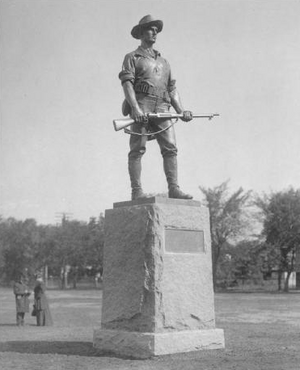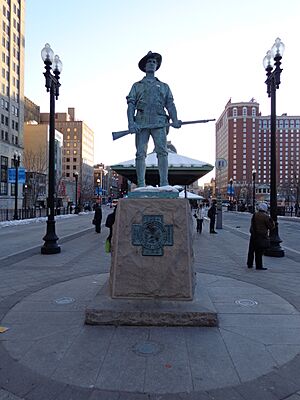The Hiker (Kitson) facts for kids
The Hiker is a famous statue created by Theo Alice Ruggles Kitson. It was made to remember American soldiers who fought in three important conflicts: the Spanish–American War, the Boxer Rebellion, and the Philippine–American War. The very first statue was made for the University of Minnesota in 1906. But it was so popular that at least 50 copies were made and placed all over the United States.
The statue shows a soldier who looks ready for battle, not dressed up for a parade. It captures the spirit of a soldier facing tough challenges on the battlefield.
Making the Statue

When Theo Alice Ruggles Kitson created The Hiker, she was already known for making statues that honored war heroes. She chose the name "Hiker" because that's what American soldiers called themselves during the Spanish–American War and the Philippine–American War.
A man named Leonard Sefing, Jr., who was a veteran from the Spanish–American War, became the model for the statue. His photograph was chosen in a national contest.
The first Hiker statue was shown to the public on Memorial Day in 1906. It stands at the University of Minnesota in front of the armory building. This statue is also called the Student Soldier Memorial. It honors 218 students from the university who served in the Spanish–American War. The statue is 9 feet (2.7 meters) tall and stands on a 6-foot (1.8 meters) granite base. The soldier wears a uniform from that time, a special hat called a campaign hat, and carries a Krag-Jørgensen rifle. Today, this first statue is often called Iron Mike, though its rifle muzzle is now missing.
Where You Can Find The Hiker

Kitson's Hiker statue became very popular. People liked how realistic it looked and how accurately it showed the soldiers of that time. In 1921, a company called Gorham Manufacturing Company bought the rights to make copies of the statue. Over the next 44 years, Gorham made at least 50 Hiker statues.
Many of the first statues were placed in the northeastern parts of the United States. After World War II, most new statues were put up in the South and West.
Because these statues are found in so many different places, they were even used in a study in 2009. This study looked at how air pollution affected bronze statues over a long time. The Hiker statues were perfect for this because they all look similar, are made of similar materials, are spread out widely, and have been around for a long time.
Some of the places where you can find a Hiker statue include:
- Minneapolis, Minnesota (1906): This is the original statue at the University of Minnesota.
- Providence, Rhode Island (1911): This statue remembers the sons of Providence who served in the wars.
- Schenectady, New York (1921): This Hiker statue overlooks Iroquois Lake.
- Lynn, Massachusetts (1923): This statue was put up by the City of Lynn to honor its soldiers.
- Allentown, Pennsylvania (1937): This statue is special because Leonard Sefing, Jr., the model for the statue, was from Allentown.
- Savannah, Georgia (1931): This statue is officially called "The Georgia Volunteer." It was placed in Savannah because that city had more Spanish–American War soldiers per person than any other city in Georgia.
- Austin, Texas (1951): This Hiker is the last war memorial added to the grounds of the Texas State Capitol.
- Arlington, Virginia (1965): This statue is located near Arlington National Cemetery and is part of the United Spanish War Veterans Memorial.
Images for kids















































